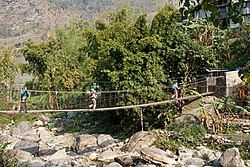Lumle लुम्ले | |
|---|---|
 Bridge over Dhoti Khola | |
| Coordinates: 28°21′N83°50′E / 28.35°N 83.83°E | |
| Country | |
| Zone | Gandaki Zone |
| District | Kaski District |
| Population (1991) | |
• Total | 4,685 |
| Time zone | UTC+5:45 (NST) |
| Area code | 061 |


Lumle is a town and Annapurna Rural Municipality, Kaski Kaski District in the Gandaki Zone of northern-central Nepal.[ clarification needed ] At the 1991 Nepal census, it had a population of 4,685 persons in 955 individual households. [1]
Contents
Lumle is well known for its agricultural centre on a hillside above the village founded in 1968 to train British Gurkha ex-servicemen farmers. Its role was expanded in 1975 to benefit the communities from which Gurkhas were recruited in Mid-West Hills. It is now part of Nepal Agricultural Research Council. [2]


